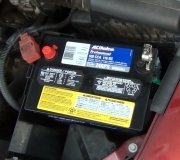What do you mean "bother"? This is what we do.
What have you found with that orange wire? Where did you disconnect it from, or what does it feed? I DO know on the older '80s radios the orange wire was the 12 volt memory feed but I never looked to see if the same color wire was used on the car's harness. The connectors plug into the radio directly for the speakers and switched 12 volts, but the memory 12 volts and dash back lighting are on a separate wired-in plug that was clipped to the back. I've repaired a lot of those radios. That's how I remember the orange wire.
GM also used an orange wire to feed the brake light switch. That circuit and the radio memory remain live all the time but the current drain would normally be way too small to light up a test light in series with a battery cable, if that's what you're doing. Depending on the size of the bulb you're using, it's going to have to pass a good half amp to light up fairly bright. The bulb's resistance will also limit current flow a little. That means when the bulb is removed and you connect the battery cable directly, even more current will flow to whatever is draining the battery. A half amp will close to kill a battery overnight; over a weekend for sure.
You don't want to ground any wire with voltage on it. That will cause too much current flow and pop a fuse. Disconnecting things and watching for the test light to go out is the way to approach it.
It occurs to me the cigarette lighter might be on the same circuit. If it is, it will normally work with the ignition switch turned off. They have been known to short or not release the lighter when it gets hot. To prevent a fire, there is a second thermal cutout built into the back of the socket. That will heat up and trip, then reset automatically in a few minutes. Over time, the average current will kill a battery in perhaps a few hours. Putting a test light in series with a battery cable will cut down a lot on the current flow and probably prevent the defective lighter or socket from getting hot enough to trip the cutout. If that is a suspect, there will be either a single wire plugged into a threaded stud on the back of the socket or there will be a two-pin connector that must be unplugged. As a test, you can unplug either type of connector and just let it hang. There's insulation around it so the terminal(s) won't touch anything metal in the car and short out.
Wednesday, October 19th, 2011 AT 3:36 AM

